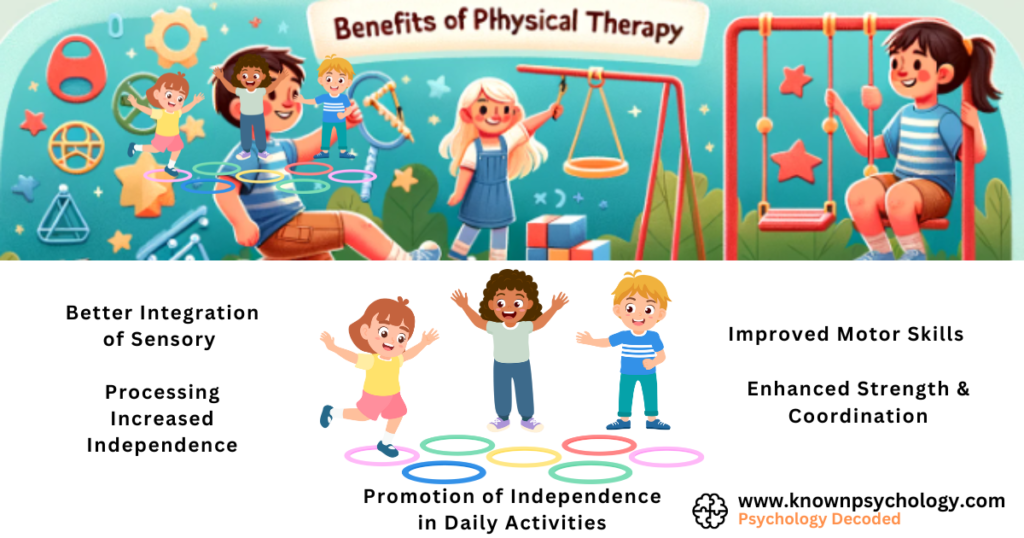
Autism Spectrum Disorder (ASD) is a complex developmental condition that involves persistent challenges in social interaction, speech, and nonverbal communication, along with restricted/repetitive behaviors. The range and severity of symptoms can vary widely. While there is no cure for autism, various therapies, including Physical Therapy for Autism, can significantly help manage symptoms and improve quality of life. This blog explores how physical therapy can be beneficial for individuals with autism, detailing the specific advantages it offers.
What is Physical Therapy for Autism?
Physical Therapy for Autism refers to a customized therapeutic approach designed to address the physical challenges faced by individuals with ASD. These challenges may include muscle weakness, lack of coordination, and difficulties with motor skills which can affect daily functioning and overall well-being. Physical therapists specially trained to work with autistic individuals develop tailored programs that focus on enhancing physical abilities and integrating sensory integration techniques to help manage the sensory processing issues often associated with autism.
Benefits of Physical Therapy for Autism
Physical therapy for children with Autism Spectrum Disorder (ASD) is tailored to meet individual needs and challenges, focusing on enhancing physical capabilities and promoting better integration into daily activities. Here are some examples and strategies commonly used in physical therapy for autistic children:
1. Development of Gross Motor Skills
Gross motor skills involve large muscle movements such as walking, running, and jumping. Physical therapists might use activities such as:
- Obstacle Courses: These can be designed to challenge balance, coordination, and agility. For example, navigating through cones, stepping over hurdles, or crawling under nets.
- Ball Games: Playing with balls of various sizes can help improve coordination and team interaction skills. Catching, throwing, and kicking can be adapted to the child’s skill level and progressively advanced as they improve.
- Trampoline Therapy: Jumping on a trampoline can help with joint attention, balance, and muscle strength, besides being a fun activity that most children enjoy.
2. Enhancement of Fine Motor Skills
Fine motor skills are crucial for tasks like writing, buttoning clothes, and using utensils. Therapists may incorporate:
- Peg Boards: Inserting pegs into boards helps improve hand-eye coordination and dexterity.
- Craft Activities: Simple crafts that involve gluing, cutting with safety scissors, and assembling pieces can improve fine motor precision and grasp.
- Therapeutic Putty Exercises: Squeezing, stretching, and manipulating putty are excellent ways to build hand strength and control.
3. Sensory Integration Therapy
Many children with autism have sensory processing issues; they may be over-sensitive or under-sensitive to physical stimuli. Physical therapists use sensory integration techniques to help children manage these sensitivities:
- Brushing Protocols: Using a soft brush on the skin can help reduce sensory defensiveness.
- Swings and Vestibular Activities: Different types of swings that move in various directions can help a child better process vestibular sensory input, which is important for balance and spatial orientation.
- Weighted Vests or Blankets: These can provide proprioceptive input, which helps calm and organize the nervous system.
4. Strengthening and Conditioning
Strengthening muscles and overall conditioning can be important, especially if the child has hypotonia (low muscle tone) which is common in autistic children. Therapists might use:
- Resistance Activities: Using bands, weighted balls, or other resistance tools to build muscle strength.
- Climbing Activities: Climbing on ladders, ropes, or rock climbing walls can help improve muscle tone, strength, and problem-solving skills.
- Aquatic Therapy: Water provides natural resistance and is often a soothing environment for sensory integration. Swimming and water games can improve physical strength and endurance.
5. Promotion of Independence in Daily Activities
Physical therapy also aims to increase a child’s independence in daily activities through:
- Self-care Routines: Exercises that mimic daily activities, such as dressing, grooming, and organizing personal items.
- Mobility Training: Use of mobility aids if necessary, and training to navigate different terrains and environments.
- Adaptive Play: Incorporating adaptive tools that enable successful participation in play, which is crucial for peer interactions and personal development.
Case Example
Imagine a child, Emma, who struggles with both sensory processing and coordination. Her physical therapist might set up sessions that begin with a sensory warm-up using brushing techniques, followed by obstacle courses that include different textures underfoot and a variety of visual and auditory cues. Each session might end with a calming activity, like swinging gently in a hammock, to help her process the sensory input from the therapy in a soothing way.
These strategies are not just exercises; they are building blocks for a child’s growth, confidence, and eventual independence. Physical therapists working with autistic children are trained to adapt these strategies based on the child’s progress and response to therapy.
A note from Known_Psychology
Physical Therapy for Autism is a vital component of the support system for individuals with autism, providing numerous benefits that can significantly enhance their physical abilities and overall quality of life. By focusing on individual needs and incorporating a variety of engaging exercises and activities, physical therapists play a crucial role in helping individuals with autism achieve greater independence and confidence. Whether it’s improving motor skills, enhancing sensory processing, or increasing physical strength, the interventions used in physical therapy are essential for addressing the unique challenges faced by those on the autism spectrum.


